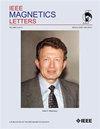Magnetic-Particle-Discrimination Method Using Difference of Relaxation Time for Magnetic Particle Imaging
IF 1.1
4区 物理与天体物理
Q4 ENGINEERING, ELECTRICAL & ELECTRONIC
引用次数: 0
Abstract
Magnetic particle imaging (MPI) is an imaging modality that directly detects the nonlinear responses of magnetic nanoparticles (MNPs). Spatial encoding is achieved by saturating the magnetic moment of MNPs almost everywhere except in a special point called the field-free region in which a magnetic field vanishes. Recently, MPI sensitivity was improved using a field-free line (FFL) in which a field-free region was formed as a line. An MPI with an FFL device was developed using a neodymium magnet and an iron yoke to image objects with a small amount of MNPs, such as in biological systems. We have been developing MPI equipment for detecting amyloid-β, a causative agent of Alzheimer's disease. We attached amyloid-β probes to nanoparticles. In our development, we discriminated between magnetic particles that are bound to biological tissue from those that are suspended in the brain. We focused on the differences in relaxation times due to the change in the hydrodynamic diameter between the bound and unbound particles. Because the bound particles have a larger apparent particle size and do not rotate when an ac magnetic field is applied, the relaxation time is different from the unbound particles. Since the differences in the responses to the ac magnetic field appear as relaxation times, we investigated a particle-discrimination method using these differences and studied the magnetization response of MNPs using our developed MPI device.基于弛豫时间差的磁粉成像鉴别方法
磁粉成像(MPI)是一种直接检测磁性纳米颗粒(MNP)非线性响应的成像方式。空间编码是通过使MNP的磁矩几乎在任何地方饱和来实现的,除了在一个被称为磁场消失的无场区域的特殊点。最近,使用其中无场区域形成为线的无场线(FFL)来提高MPI灵敏度。使用钕磁体和铁轭开发了一种带有FFL设备的MPI,用于对具有少量MNP的物体进行成像,例如在生物系统中。我们一直在开发MPI设备来检测淀粉样蛋白-β,一种阿尔茨海默病的病原体。我们将淀粉样蛋白-β探针连接到纳米颗粒上。在我们的发展过程中,我们区分了与生物组织结合的磁性粒子和悬浮在大脑中的磁性粒子。我们重点研究了由于结合粒子和未结合粒子之间流体动力学直径的变化而导致的弛豫时间的差异。由于结合粒子具有较大的表观粒径,并且在施加交流磁场时不旋转,因此弛豫时间与未结合粒子不同。由于对交流磁场的响应差异表现为弛豫时间,我们研究了一种利用这些差异的粒子判别方法,并使用我们开发的MPI设备研究了MNP的磁化响应。
本文章由计算机程序翻译,如有差异,请以英文原文为准。
求助全文
约1分钟内获得全文
求助全文
来源期刊

IEEE Magnetics Letters
PHYSICS, APPLIED-
CiteScore
2.40
自引率
0.00%
发文量
37
期刊介绍:
IEEE Magnetics Letters is a peer-reviewed, archival journal covering the physics and engineering of magnetism, magnetic materials, applied magnetics, design and application of magnetic devices, bio-magnetics, magneto-electronics, and spin electronics. IEEE Magnetics Letters publishes short, scholarly articles of substantial current interest.
IEEE Magnetics Letters is a hybrid Open Access (OA) journal. For a fee, authors have the option making their articles freely available to all, including non-subscribers. OA articles are identified as Open Access.
 求助内容:
求助内容: 应助结果提醒方式:
应助结果提醒方式:


